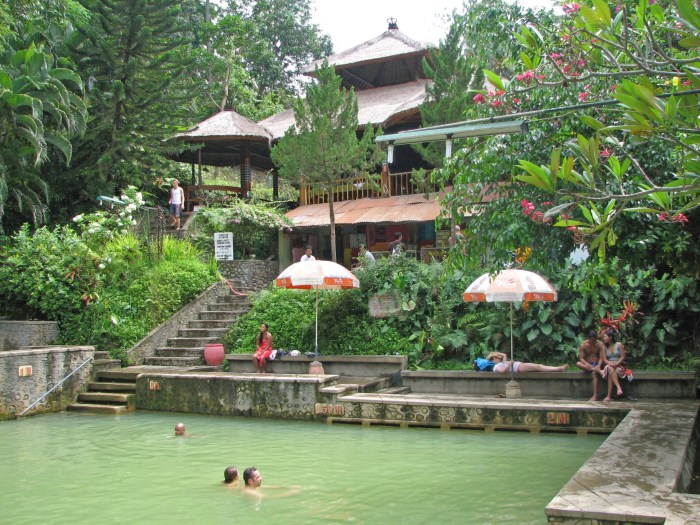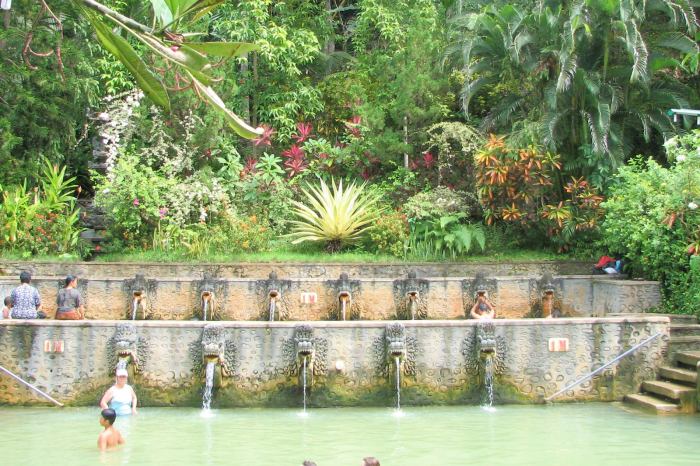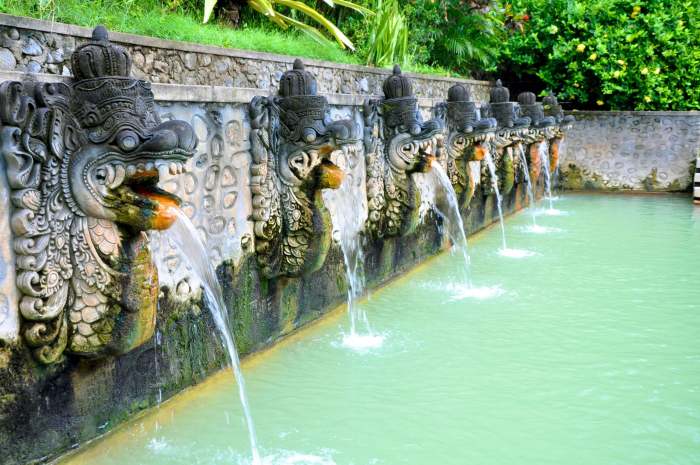Banjar, a captivating ethnic group from South Kalimantan, Indonesia, boasts a rich cultural tapestry that has been meticulously preserved and celebrated throughout the ages. From their distinctive cuisine to their vibrant festivals and architectural marvels, the Banjar people have left an indelible mark on the Indonesian cultural landscape.
Their unique identity is a harmonious blend of indigenous traditions, Islamic influences, and external cultural exchanges, resulting in a fascinating mosaic that continues to captivate and inspire.
Banjar Culture
Banjar culture is a vibrant and diverse tapestry of traditions, beliefs, and customs that have been passed down through generations in the South Kalimantan region of Indonesia. Its roots can be traced back to the early Malay kingdoms that flourished in the area, with influences from Javanese, Chinese, and Indian cultures.
Traditional Practices
Banjar society is highly communal, with a strong emphasis on family and kinship ties. Traditional practices include the gotong royongsystem of communal labor, where villagers work together to complete tasks such as building houses or harvesting crops.
Beliefs and Customs
Banjar people hold a deep respect for their ancestors and the spirits of nature. They practice a form of animism called Kaharingan, which believes that all things, from trees to rivers, have a spirit. Traditional ceremonies and rituals are performed to appease these spirits and bring good fortune.
Banjar, located in the east of Bali, is a region with a rich cultural heritage. One of its most iconic landmarks is the Lempuyang Temple , a sacred site perched on the slopes of Mount Lempuyang. This temple complex is known for its stunning views and intricate architecture, making it a popular destination for pilgrims and tourists alike.
Banjar is also home to several other important temples and cultural sites, making it a must-visit destination for those interested in exploring Bali’s spiritual and historical heritage.
Music, Dance, and Art Forms
Banjar culture is renowned for its rich artistic traditions. Kuda Lumping, a traditional horse dance, is a popular form of entertainment at festivals and celebrations. Banjar music is characterized by its use of the panting, a plucked string instrument, and the gendang, a double-headed drum.
- Kuda Lumping: A dynamic horse dance that involves intricate choreography and colorful costumes.
- Panting: A plucked string instrument with a distinctive, twanging sound.
- Gendang: A double-headed drum that provides the rhythmic foundation for Banjar music.
- Wayang Kulit: A shadow puppet theater that tells stories from Hindu mythology and Javanese folklore.
Banjar Cuisine
Banjar cuisine is a unique and flavorful blend of Indonesian, Chinese, and Malay influences. It is known for its use of fresh ingredients, bold flavors, and spicy dishes.
One of the most distinctive features of Banjar cuisine is its use of a spice paste called bumbu. Bumbuis made from a variety of ingredients, including garlic, shallots, ginger, turmeric, and chili peppers. It is used to flavor many different dishes, including curries, soups, and stir-fries.
Preparation Methods
Banjar cuisine is typically prepared using traditional methods. Many dishes are cooked over a wood fire, which gives them a unique smoky flavor. Rice is a staple food in Banjar cuisine, and it is often served with a variety of side dishes, such as vegetables, fish, and meat.
Traditional Dishes
Some of the most popular traditional Banjar dishes include:
- Soto Banjar: A spicy soup made with chicken, beef, or fish, and vegetables.
- Nasi Kuning: A yellow rice dish cooked with turmeric and coconut milk.
- Gangan Asam: A sour fish soup made with tamarind and vegetables.
- Ketupat Kandangan: A sticky rice dumpling wrapped in woven palm leaves.
Comparison with Other Regional Indonesian Cuisines
Banjar cuisine shares some similarities with other regional Indonesian cuisines, but it also has its own unique characteristics. The following table compares Banjar cuisine with some other popular Indonesian cuisines:
| Cuisine | Region | Characteristics |
|---|---|---|
| Banjar | South Kalimantan | Use of bumbu spice paste, bold flavors, spicy dishes |
| Padang | West Sumatra | Use of spicy chili peppers, beef rendang |
| Javanese | Java | Use of sweet soy sauce, fried chicken, rice dishes |
| Balinese | Bali | Use of fresh vegetables, seafood, spicy dishes |
Banjar Architecture

Banjar architecture is a unique blend of traditional Indonesian and Islamic influences. The houses are typically built on stilts, with a raised floor and a thatched roof. The walls are made of woven bamboo or wood, and the windows are often decorated with intricate carvings.
There are several different types of Banjar houses, each with its own unique characteristics. The most common type of house is the rumah adat, or traditional house. Rumah adat are typically large and spacious, with a central living area and several bedrooms.
They are often decorated with intricate carvings and paintings.
Another type of Banjar house is the rumah panggung, or stilt house. Rumah panggung are typically smaller and more modest than rumah adat, and they are often built on stilts to protect them from flooding. They are typically made of wood or bamboo, and they have a raised floor and a thatched roof.
Banjar architecture is not only functional, but it is also highly symbolic. The raised floor of the house represents the separation of the human world from the spirit world. The thatched roof represents the protection of the house from the elements.
And the intricate carvings and paintings represent the wealth and status of the family.
Building Materials
The traditional materials used in Banjar architecture are wood, bamboo, and thatch. Wood is used for the frame of the house, while bamboo is used for the walls and roof. Thatch is used for the roof covering.
In recent years, however, more modern materials have been used in Banjar architecture, such as concrete and metal. These materials are more durable and easier to maintain than traditional materials, but they are also more expensive.
Architectural Elements
Some of the most common architectural elements in Banjar architecture include:
- Raised floor:The raised floor of the house represents the separation of the human world from the spirit world.
- Thatched roof:The thatched roof represents the protection of the house from the elements.
- Intricate carvings and paintings:The intricate carvings and paintings represent the wealth and status of the family.
- Verandah:The verandah is a covered porch that is often used for entertaining guests.
- Gable:The gable is the triangular section of the roof that is often decorated with carvings or paintings.
Banjar Language

The Banjar language is an Austronesian language spoken by the Banjar people of South Kalimantan, Indonesia. It is closely related to the Malay language and is part of the Malayo-Polynesian branch of the Austronesian family.
The Banjarmasin dialect, spoken in South Kalimantan, is distinct from the Banjar dialect spoken in central jakarta. Despite their shared name, the two dialects differ in vocabulary, grammar, and pronunciation. The Banjarmasin dialect is more heavily influenced by Malay, while the Banjar dialect spoken in central jakarta has more Javanese influence.
Both dialects are rich in vocabulary and have a complex grammatical structure.
The Banjar language is believed to have originated from the Proto-Malay language, which was spoken in Southeast Asia around 2,000 years ago. The Proto-Malay language split into several different languages, including Malay, Banjar, and Iban. The Banjar language was brought to South Kalimantan by the Banjar people, who migrated from the Malay Peninsula around the 14th century.
Linguistic Features
The Banjar language has a number of distinctive linguistic features, including:
- The use of the vowel /ə/ in place of the vowel /a/ in many words.
- The use of the consonant /ŋ/ in place of the consonant /n/ in many words.
- The use of the consonant /h/ in place of the consonant /s/ in many words.
Dialects
There are a number of different dialects of the Banjar language, including:
- The Banjar Kuala dialect, which is spoken in the Banjarmasin area.
- The Banjar Hulu dialect, which is spoken in the Hulu Sungai area.
- The Banjar Martapura dialect, which is spoken in the Martapura area.
Proverbs, Idioms, and Traditional Songs
The Banjar language is rich in proverbs, idioms, and traditional songs. Here are a few examples:
Proverbs
- “Alah bisa karena biasa.”(Practice makes perfect.)
- “Berakit-rakit ke hulu, berenang-renang ke tepian. Bersakit-sakit dahulu, bersenang-senang kemudian.”(No pain, no gain.)
- “Di mana bumi dipijak, di situ langit dijunjung.”(When in Rome, do as the Romans do.)
Idioms
- “Bagai pungguk merindukan bulan.”(To desire something that is unattainable.)
- “Buaya darat.”(A womanizer.)
- “Makan hati.”(To be jealous.)
Traditional Songs
- “Ampar-ampar Pisang.”(A folk song about a banana tree.)
- “Baisah.”(A love song.)
- “Parang Ilang.”(A song about a lost sword.)
Banjar Festivals and Celebrations
The Banjar people of South Kalimantan, Indonesia, observe a variety of festivals and celebrations that are deeply rooted in their culture and religion. These events provide opportunities for the community to come together, preserve traditions, and honor their heritage.
Major Festivals and Celebrations
The Banjar people celebrate several major festivals throughout the year, including:
- Habsyi Festival: A cultural and religious festival that showcases the traditional Habsyi music and dance, which has Arabic and Islamic influences.
- Maulid Nabi: A celebration of the birth of the Prophet Muhammad, featuring religious ceremonies, processions, and communal feasts.
- Eid al-Fitr: The end of the fasting month of Ramadan, marked by prayers, family gatherings, and traditional culinary delights.
- Eid al-Adha: The festival of sacrifice, commemorating the Prophet Ibrahim’s willingness to sacrifice his son Ismail. Animals are slaughtered and the meat is distributed among the community.
Cultural and Religious Significance
These festivals play a crucial role in preserving and transmitting Banjar culture. They provide a platform for the community to engage in traditional music, dance, and art forms, passing down these practices to future generations. Additionally, the festivals have strong religious significance, as they commemorate important events in the Islamic calendar and reinforce the community’s faith.
Upcoming Banjar Festivals
The following is a tentative timeline of upcoming Banjar festivals:
- Habsyi Festival: May (dates vary)
- Maulid Nabi: October (dates vary)
- Eid al-Fitr: April 22, 2023 (estimated)
- Eid al-Adha: June 28-29, 2023 (estimated)
These dates may vary slightly depending on the lunar calendar. It is recommended to consult local sources for the most up-to-date information.
Banjar Economic Activities

The Banjar people have a diverse economy that has evolved over centuries. Traditional economic activities such as agriculture, fishing, and trade continue to play a significant role, while modern industries such as tourism and manufacturing have also emerged.
Agriculture
Agriculture is the mainstay of the Banjar economy. The fertile soils and abundant rainfall of the Banjarmasin region make it ideal for growing a variety of crops, including rice, rubber, and coconuts. Rice is the staple food of the Banjar people, and it is also exported to other parts of Indonesia.
Trade
Trade has been an important part of the Banjar economy for centuries. The Banjar people have a long history of trading with other ethnic groups in Indonesia and Southeast Asia. Today, Banjarmasin is a major trading center for the region.
Tourism
Tourism is a growing industry in the Banjarmasin region. The city is home to a number of historical and cultural attractions, including the Banjarmasin Grand Mosque and the Sultan Suriansyah Museum. The region is also home to a number of beautiful beaches and islands, which are popular with tourists.
Challenges and Opportunities, Banjar
The Banjar economy faces a number of challenges, including poverty, unemployment, and environmental degradation. However, there are also a number of opportunities for economic growth. The development of tourism and manufacturing industries has the potential to create jobs and boost the economy.
Banjar Diaspora

The Banjar people have a long history of migration outside of their traditional homeland in South Kalimantan, Indonesia. This diaspora has been driven by various factors, including economic opportunities, political unrest, and religious persecution.
Distribution and Settlement Patterns
Today, Banjar communities can be found in many parts of the world, including Malaysia, Singapore, Brunei, Thailand, Myanmar, and Australia. In Malaysia, the Banjar are concentrated in the states of Sabah and Sarawak, where they make up a significant portion of the population.
In Singapore, the Banjar are a recognized ethnic group, and they have their own mosques and cultural organizations.
Impact on Cultural Preservation and Exchange
The Banjar diaspora has had a significant impact on cultural preservation and exchange. Banjar communities outside of Indonesia have been able to maintain their cultural traditions and identity, while also adapting to their new environments. This has led to the development of new cultural forms, such as Banjar music and dance that incorporate elements from other cultures.
Banjar, a traditional village in Bali, is renowned for its lush rice paddies and intricate water temples. Immerse yourself in the tranquility of this cultural haven and explore its enchanting surroundings. Just a short drive away, discover the opulent ayodya resort bali , where you can indulge in unparalleled luxury amidst the island’s natural beauty.
Upon your return to Banjar, continue your exploration of this captivating village, immersing yourself in its vibrant traditions and the warmth of its people.
At the same time, the Banjar diaspora has also played a role in introducing Indonesian culture to other parts of the world. Banjar communities have established mosques, cultural centers, and businesses that have helped to promote Indonesian culture and traditions.
Banjar Social Structure

The Banjar people traditionally had a hierarchical social structure, with the ruling class at the top and the commoners at the bottom. The ruling class was further divided into several ranks, with the highest rank being the sultan. The sultan was the head of state and had absolute power.
He was assisted by a council of ministers, who were responsible for running the government.The commoners were divided into several classes, based on their occupation. The highest class was the farmers, who were followed by the fishermen, the craftsmen, and the traders.
The lowest class was the slaves, who were owned by the ruling class.The Banjar social structure has changed significantly in modern times. The sultanate was abolished in the early 20th century, and the Banjar people are now governed by a democratic government.
The old class distinctions have also largely disappeared, and the Banjar people are now more egalitarian than they were in the past.
Roles and Responsibilities of Different Social Groups and Individuals
In the traditional Banjar social structure, the ruling class was responsible for governing the state and maintaining law and order. The commoners were responsible for producing food and other goods and services. The slaves were responsible for performing menial tasks.In modern times, the roles and responsibilities of different social groups and individuals have changed significantly.
The government is now responsible for governing the state and maintaining law and order. The people are responsible for electing their leaders and holding them accountable. The economy is now based on a variety of industries, and people are free to choose their own occupations.
Changes and Challenges Facing Banjar Social Structures in Modern Times
The Banjar social structure has undergone significant changes in modern times. The most significant change has been the abolition of the sultanate and the establishment of a democratic government. This change has led to a more egalitarian society, in which all citizens are equal before the law.Another major change has been the development of a modern economy.
This change has led to a more diverse social structure, with people from different backgrounds and occupations living and working together.These changes have also brought about a number of challenges. One challenge is the need to create a more inclusive society, in which all citizens feel like they belong.
Another challenge is the need to address the economic disparities that exist between different social groups.Despite these challenges, the Banjar social structure is adapting to the changing times. The Banjar people are proud of their heritage and are working to create a more just and equitable society for all.
Last Point: Banjar
As we delve into the captivating world of Banjar culture, we discover a treasure trove of traditions, beliefs, and artistic expressions that have been passed down through generations. From their delectable cuisine to their enchanting architecture and vibrant festivals, the Banjar people have woven a rich tapestry of heritage that continues to enrich the cultural fabric of Indonesia.
Answers to Common Questions
What is the origin of the Banjar people?
The Banjar people are believed to have originated from the merger of several indigenous groups in South Kalimantan, influenced by Malay, Javanese, and Chinese traders.
What are some of the traditional Banjar dishes?
Banjar cuisine is known for its flavorful dishes such as Soto Banjar (chicken soup), Gangan Asam (sour fish soup), and Nasi Kuning (yellow rice).
What is the significance of Lambung Mangkurat in Banjar culture?
Lambung Mangkurat is a legendary figure revered as the founder of the Banjar kingdom and is considered a symbol of Banjar identity and pride.